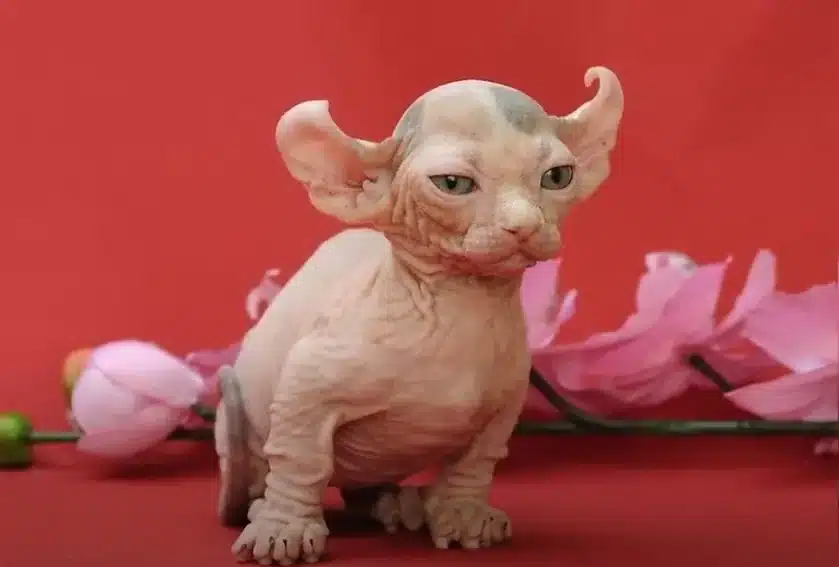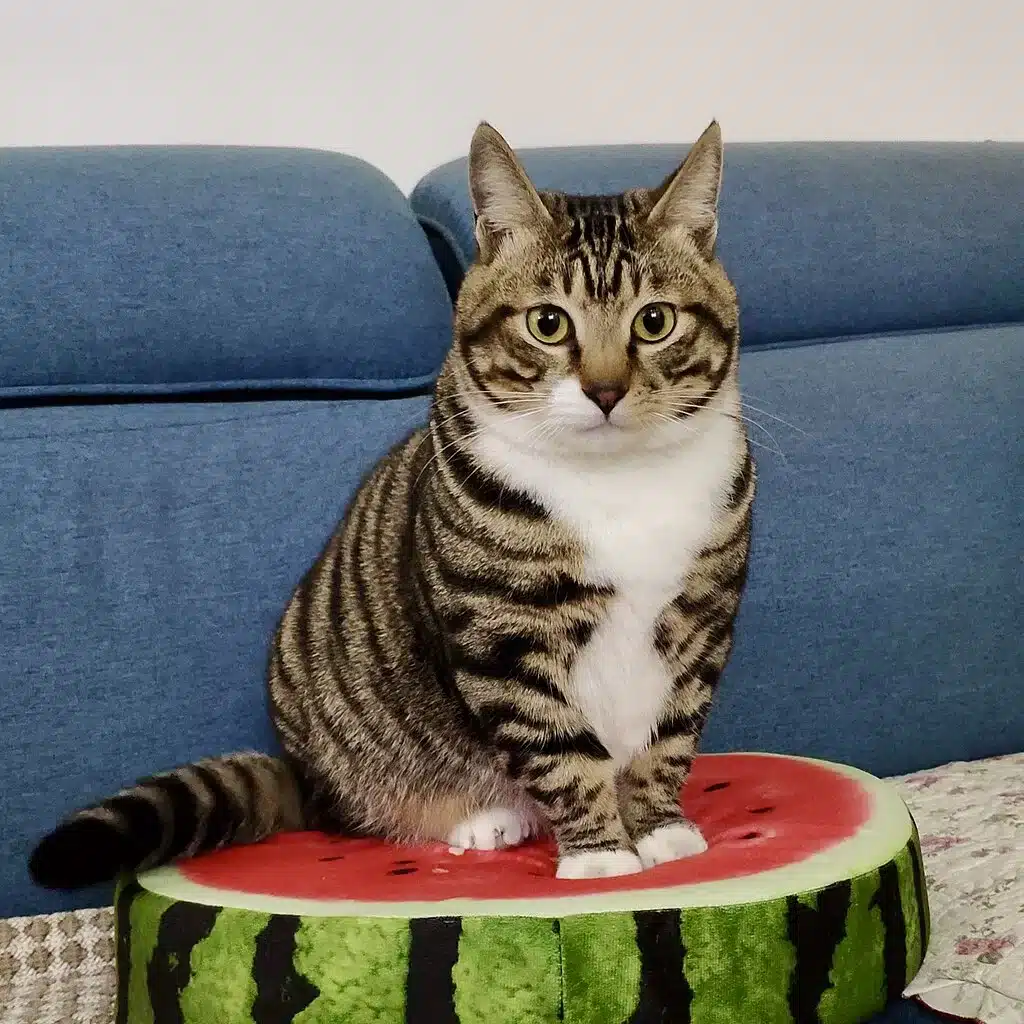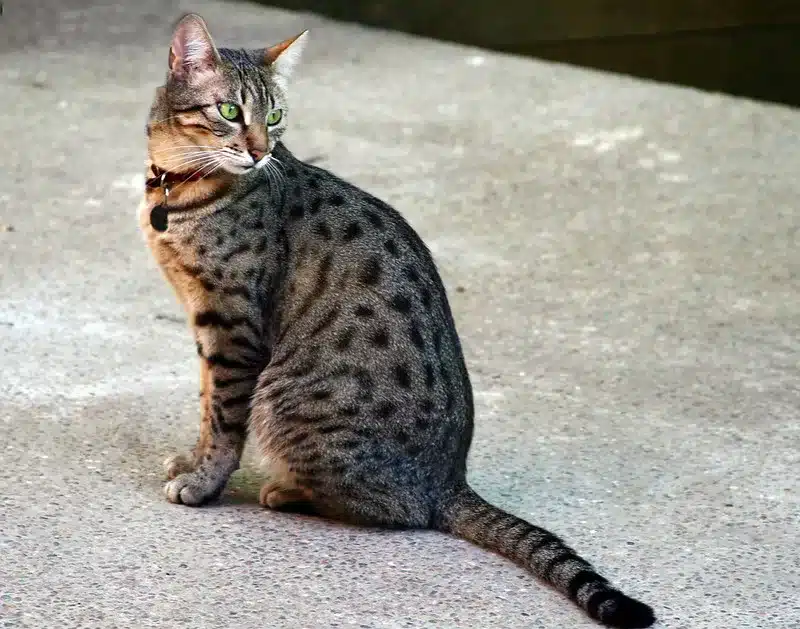
Dwelf Cats: Care and Personality | What You Need to Know If You’re Thinking of Getting a Dwelf Cat
This post contains affiliate links. Read the full disclosure here.
- Dwelf cats originated in the United States.
- They have the hairlessness of a Sphynx, the short legs of the Munchkin, and the curled ears of the American Curl.
- Dwelf cats are social and playful.
- They can live for 12 to 15 years.
- Their ideal owner is someone who stays at home a lot.
Are you a homebody looking for a unique feline companion? In the vast world of cat breeds, the Dwelf cat stands out as a captivating addition to any household. With their enchanting appearance and delightful personality, the Dwelf offers a one-of-a-kind experience for cat lovers. From their origin to their care needs and special considerations, there’s much to discover about this fascinating breed.
Join me in exploring the world of Dwelf cats and learn everything you need to know before welcoming one into your home.
Brief History
The Dwelf cat breed emerged in the United States and is a relatively recent addition to the cat world. It is generally agreed that the Dwelf made its first appearance after 2005, around the same time as the Bambino breed, to which it is closely related.
The name ‘Dwelf’ ingeniously blends the words ‘dwarf’ and ‘elf,’ reflecting the breed’s small stature and enchanting appearance. These cats are indeed petite, with their dwarfism setting them apart from other breeds. Their elf-like charm is further accentuated by their curled ears, reminiscent of the American Curl.
The creation of the Dwelf cat was a deliberate effort by breeders who aimed to produce a breed with specific physical traits and a unique personality. This was achieved by crossbreeding the Sphynx, known for its hairlessness, the Munchkin, recognized for its short legs, and the American Curl, celebrated for its distinctive ears. The result is a breed that boasts the hairless quality of the Sphynx, the short stature of the Munchkin, and the curled ears of the American Curl.
As a testament to their novelty, the International Cat Association (TICA) has only recently recognized the Dwelf under its Experimental New Breeds category. This acknowledgement highlights the breed’s youth and the ongoing development of its standard.

Physical Features
Dwelf cats stand out with their hairless, wrinkled skin and elf-like ears, which curl back from the face. They are small in stature, typically reaching heights of 6 to 7 inches and weighing between 4 and 9 pounds.
Characterized by their short, slender legs, Dwelf cats possess a compact and muscular build that adds to their dwarf-like appearance. On the other hand, their large, expressive eyes and short muzzles give them an endearing look that captures hearts. While they may or may not have whiskers and eyebrows, their overall appearance is undeniably charming.
Despite common misconceptions, though, these cats are not hypoallergenic. The absence of fur does not eliminate the presence of allergens, which are found in a cat’s saliva and urine. Therefore, potential owners with allergies should consider this before welcoming a Dwelf into their home.

Personality
The Dwelf cat is a delightful companion, known for their outgoing and friendly temperament. This breed exhibits a strong social inclination, thriving on interaction with humans and rarely enjoying solitude. They are particularly suited for individuals or families who spend considerable time at home, as they do not appreciate being left alone for extended periods.
In terms of activity, Dwelf cats are surprisingly lively and playful, despite their small size. They exhibit a playful demeanor, often engaging in games of chase and enjoying climbing on various surfaces. Their behavior is sometimes likened to that of dogs, given their energetic and interactive nature. In addition, their intelligence makes them relatively easy to train with positive reinforcement techniques.
When it comes to independence, the Dwelf cat strikes a balance. While they cherish companionship, they also display an independent streak, allowing them to entertain themselves when necessary. However, they are happiest in the presence of their owners, showing great affection and loyalty.
Dwelf cats generally get along well with children and other pets, making them a suitable addition to a diverse household. They adapt to new people and environments, although they prefer a consistent routine and may take some time to adjust to changes. Once settled, though, they become very affectionate members of the family.
RELATED ARTICLE: Understanding Cat Behaviors: 140 Cat Behaviors Explained
Health Issues & Lifespan
Due to their relatively new status as a breed, long-term health data is still being gathered about the hereditary diseases that Dwelf cats are prone to. However, some potential issues are associated with their unique physical characteristics.
- Skeletal Concerns: The short legs and folded ears that contribute to the Dwelf’s distinctive appearance can also predispose them to skeletal problems. Conditions like osteochondrodysplasia (abnormal bone and cartilage development) and pectus excavatum (sunken chest) can occur. These issues can manifest as lameness, joint pain, and difficulty breathing in severe cases. Regular veterinary checkups and maintaining a healthy weight are essential for managing these conditions.
- Skin Sensitivities: Hairless cats like the Dwelf lack the natural protection fur provides. This makes their skin more susceptible to sunburn, dryness, and irritations. As such, regular baths with a gentle shampoo designed for sensitive skin and providing sunscreen during outdoor exposure are important for maintaining healthy skin.
- Dental Health: While not exclusive to Dwelves, some brachycephalic (short-faced) cats can have dental overcrowding due to the shortened jaw structure. In this regard, regular dental checkups and cleanings are important to prevent periodontal disease, a common issue in felines.
- Genetic Predispositions: As with any breed, Dwelves may have a genetic predisposition for certain health problems. Early research suggests a potential link to heart disease, but further investigation is needed. Responsible breeders will screen their breeding stock for known genetic conditions to minimize the risk of passing them on to offspring.
Due to the breed’s newness, definitive data on lifespan is limited. However, estimates suggest an average lifespan of 12–15 years. With proper care, including a balanced diet, regular veterinary checkups, and addressing any health concerns promptly, your Dwelf companion can live a happy and healthy life.

Special Care Needs
Owning a Dwelf cat is a rewarding experience, but it’s important to understand their specific needs to ensure their well-being. While they share many basic care requirements with other felines, their unique features necessitate some additional considerations.
Grooming
Unlike their fluffy counterparts, Dwelves might seem low maintenance on the grooming front. However, their hairless skin requires regular attention. Weekly baths with a gentle, pH-balanced shampoo designed for sensitive skin help remove dirt, oils, and dead skin cells, preventing dryness and irritation.
Avoid harsh soaps or frequent bathing, which can strip their skin’s natural oils. It’s also important to gently dry them with a soft towel. Some Dwelfs might even appreciate a light application of a moisturizer specifically formulated for cats.
In addition, keep in mind that their lack of fur also means they’re susceptible to sunburn. If you plan on letting your Dwelf outdoors, sunscreen formulated for cats with an SPF of 15 or higher is essential. However, it’s best to keep them indoors.
Exercise and Playtime
Dwelves might be petite, but their playful spirit demands regular exercise and mental stimulation. As such, interactive play sessions that mimic hunting behaviors are ideal. Wand toys, feather teasers, and puzzle feeders keep them engaged and help expend their energy.
Vertical spaces like cat trees or shelves cater to their love of climbing. Keep in mind that their short legs might limit their jumping ability, so ensure climbing structures are easy to navigate. Daily playtime not only combats boredom but also promotes healthy weight management and strengthens your bond with your feline friend.
Attention
Dwelf cats are known for their friendly and social nature. They enjoy interaction with their humans and don’t mind being picked up and cuddled. However, they also possess a touch of independence and can entertain themselves for short periods.
Schedule dedicated playtime and cuddle sessions throughout the day to keep them engaged and happy. If you work long hours and won’t be home much, a Dwelf might not be the ideal breed for your lifestyle.
Living Environment
Due to their lack of fur, Dwelves can feel the cold more acutely than other cats. Providing cozy beds and perches in draft-free areas is essential for their comfort. Consider heated cat beds during colder months.
Special Care Considerations
Regular veterinary checkups are essential for all cats, but even more so for Dwelves due to their potential health concerns. These checkups allow for early detection and management of any skeletal issues, dental problems, or skin sensitivities. Mentioning the breed to your veterinarian ensures they are familiar with potential health risks and can tailor preventive care accordingly.

Fun Facts
The Dwelf cat is a fascinating breed that combines the best of three distinct feline worlds. Here are some fun facts about these enchanting creatures:
- The name ‘Dwelf’ is a blend of ‘dwarf’ and ‘elf,’ reflecting their small size and elfin features.
- Due to their hairless nature, Dwelf cats are strictly indoor pets, as they lack fur to protect them from the elements.
- Dwelf cats are considered designer breeds and can be quite rare, which is reflected in their price.
- The breed initially received recognition from the now-defunct Dwarf Cat Association, also known as the Designer Cat Association, and was later registered by the Rare and Exotic Feline Registry.
Who is the Ideal Owner of the Dwelf Cat?
The Dwelf cat’s unique personality and needs make them a great fit for some households, but not all. Here’s a breakdown of who might find a Dwelf to be the ideal feline companion:
- Social Butterflies: Dwelf cats crave attention and interaction. If you’re home often and enjoy spending quality time cuddling or playing with your cat, a Dwelf will thrive in your company.
- Playful Personalities: Their energetic and playful nature is a perfect match for someone who enjoys engaging their cat with toys, puzzle feeders, and interactive play sessions.
- Apartment Dwellers: Their small size makes them well-suited for apartment living, as long as you provide them with vertical spaces to climb and explore.
- Gentle Families: While they get along with children, due to their delicate size, supervision is necessary around very young kids. Families with older children who understand proper handling can find a loving companion in a Dwelf.
- Calm and Consistent: Dwelf cats appreciate routine and stability. If you have a predictable schedule and can offer a calm environment, they’ll adjust well.
- Meticulous Caregivers: Their hairless skin requires regular baths, sunscreen for outdoor exposure, and potential moisturizing to prevent dryness and irritation.
Final Thoughts
Dwelf cats present a charming blend of dwarfism, elfin features, and playful temperament, making them a beloved companion for those who appreciate their uniqueness. While they require special care due to their hairless nature and potential health concerns, the joy and affection they bring to their owners are immeasurable.
Whether you’re a seasoned cat enthusiast or embarking on your first feline adventure, the Dwelf cat offers a delightful journey filled with love, companionship, and endless enchantment.
Frequently Asked Questions
What is a Dwelf cat?
The Dwelf cat is a relatively new breed known for its hairless skin, curled ears, and short legs. They are playful, social, and affectionate companions.
What is the origin of the Dwelf cat?
The Dwelf cat emerged in the United States around 2005. It’s believed to have been created by breeding Sphynx, Munchkin, and American Curl cats.
What is the Dwelf cat’s size?
Dwelf cats are small, typically reaching heights of 6 to 7 inches and weighing between 4 and 9 pounds.
Are Dwelf cats hypoallergenic?
No, Dwelf cats are not hypoallergenic. While hairless, cat allergens are found in their saliva and urine.
Are Dwelf cats healthy?
Due to their new status as a breed, long-term health data is limited. However, they might be predisposed to skeletal issues, skin sensitivities, and dental problems. Regular vet checkups are important.
What is the Dwelf cat’s lifespan?
Estimates suggest an average lifespan of 12–15 years with proper care.
What are the Dwelf cat’s health problems?
Potential health problems include skeletal issues (due to short legs), skin sensitivities (due to hairless skin), and dental problems. Early research suggests a possible link to heart disease.
What is the Dwelf cat’s personality?
Dwelf cats are social, playful, and affectionate. They crave attention and interaction but can also entertain themselves for short periods of time.
How much are Dwelf cats?
Dwelf cats are considered designer breeds and can be quite rare, so they can cost up to $3,000.
Blake, M. (2019, October 31). Dwelf cat breed profile. Love to Know Pets. https://www.lovetoknowpets.com/cats/dwelf-cat-breed-profile
Breed Recognition (scroll down for list of breeds). (2024). Rare and Exotic Feline Registry. https://www.rareexoticfelineregistry.com/breed-recognition/
Cosgrove, N. (2024, January 21). Dwelf cat breed: pictures, temperament & traits. PetKeen. https://petkeen.com/cat-breeds/dwelf-cat/
Dickson, P. (2024, March 19). Dwelf cat info, pictures, temperament & traits. Catser. https://www.catster.com/guides/dwelf-cat/
Dwelf. (2009, July 27). Wayback Machine. https://web.archive.org/web/20150209012738/http:/www.the-dwarf-cat-association.com/Dwelf.html
Dwelf. (2018, September 18). International Cat Care. https://icatcare.org/advice/dwelf/
Obrien, A. (2024, February 16) Dwelf cat: 13 things to know about this hairless elf breed. The Discerning Cat. https://thediscerningcat.com/dwelf-cat/
Ochoa, D. (2023, June 19). Dwelf cat breed: the small, bald, & beautiful feline guide. Holistapet. https://www.holistapet.com/blogs/cat-breeds/dwelf
Oliver, C. (2022, December 23). Dwelf cat- personality traits of this unique breed. Snuggling Cat. https://snugglingcat.com/dwelf-cat/#google_vignette
Roberts, B. (2023, May 11). Everything you need to know about the Dwelf cats! CatVills. https://catvills.com/dwelf-cat-breed/
Tcrascolorado. (2024, January 9). Dwelf cat: origins, characteristics, and care guide. Tcrascolorado. https://www.tcrascolorado.com/dwelf-cat-origins-characteristics-and-care-guide/#origins-and-history-of-the-dwelf-cat
Veranth, E. (2021, August 26). Dwelf cat: breed history, characteristics, personality, and more. ThePets. https://thepets.net/dwelf-cat-breed/

Reina Marie Gonzales is the Founder of Sharp Minds Content LLC. She’s also an entrepreneur and a writer with over 20 years of experience. Cat mom to the sweetest and most adorable Persian kitty, her other passions include personal development, self-love, spirituality, and self-empowerment. She considers herself a lifelong learner and always sees the glass half full.


